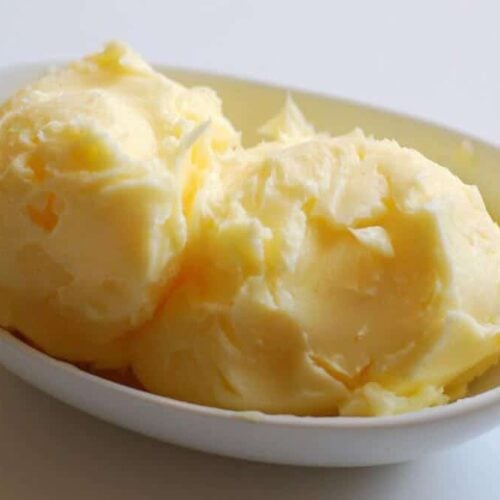Making raw, organic, homemade cultured butter couldn’t be easier. You can use 21st century equipment (a blender) to make light work of churning an ancient, traditional food.
If you wonder why anyone would make butter when it can so easily be bought at the store, there is only one answer really: TASTE. Homemade butter is better butter—much better. It is like tasting what butter used to be like, before it became a factory-made food.
In truth, butter is not the enemy Americans once feared. Researchers have upset the old-fashioned “lipid hypothesis” that blamed heart disease on animal fats. Humans have been eating animal fats for millennia without suffering heart disease, obesity or arteriosclerosis.
In fact, research is now showing us that it is the trans fats from margarine and the polyunsaturated fats like canola and soybean oils that humans have only been eating for the past 50 years that are really making our health worse.
Plus, we are now discovering how incredibly healthy foods from pasture-raised animals can be. Butter from grass-fed cows is higher in many nutrients, including vitamins A, D, E, and K, beta carotene, and essential fatty acids like CLA and Omega-3.
And raw, cultured butter contains valuable, health-supporting enzymes too!
Related: The Inconvenient Truth About Canola Oil

Homemade Cultured Butter
Ingredients
- 1 quart raw organic, whole cream , from grass-fed cows*
- 1 packet buttermilk starter culture, if needed
Instructions
- Pour the cream into a clean, sterilized bowl, add starter if using, and cover with a clean towel. Let sit in a cool area (about 55-60 degrees) or in the fridge until it cultures and thickens. Experiment with the taste of cultured cream. You can culture it as few as 8 hours or as long as a week; it’s up to you.
- The ripening cream should have a pleasant smell and develop a slightly tangy taste, sharpening with time. As the cream acidifies, it becomes hostile to toxic bacteria, but should the cream curdle, or smell or taste bad, discard it. The longer you ripen it, the more clear and distinctive the flavor of your finished butter will be.
- Once cultured to your liking, pour it into your blender. Blend for about 5 minutes on a medium setting. The cream will whip first, and you will need to stop the blender to knock it back into the blades several times.
- After a few minutes of blending, the butter will “break” from the whipped cream and start to separate into butter and buttermilk. When you notice that happening, stop the blender and let things rest for a minute to let the butter rise to the top.
- Pour the buttermilk into another container, using a spoon to press as much buttermilk out of the butter as possible. Blend again a bit more, then repeat pressing out the buttermilk. Enjoy the buttermilk in pancakes or biscuits tomorrow!
- If you want your butter to last for more than a few days, you have to “wash” it. Pour about a cup of ice cold water into the blender and blend for another 30 seconds. Pour out the water and discard, using a spoon to press as much water out of the butter as possible.
- Repeat the washing until the water runs almost clear.
- On your last washing, you can use rosemary water, rosewater, orange water or any other flavoring you’d like to add to your butter.
- When thoroughly washed, mix a little sea salt in with a spoon, if you wish.
- Store in the fridge and enjoy for the next week or two.









11 thoughts on “How to Make Cultured Butter”